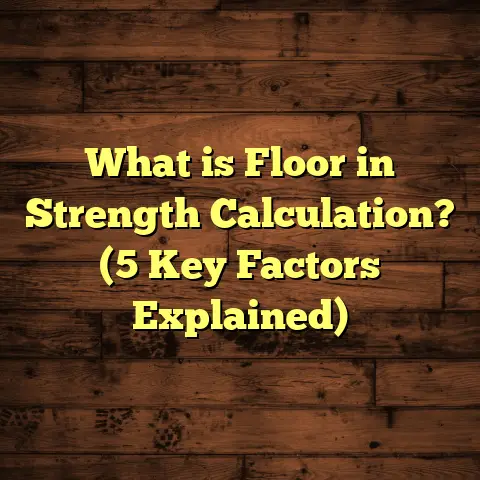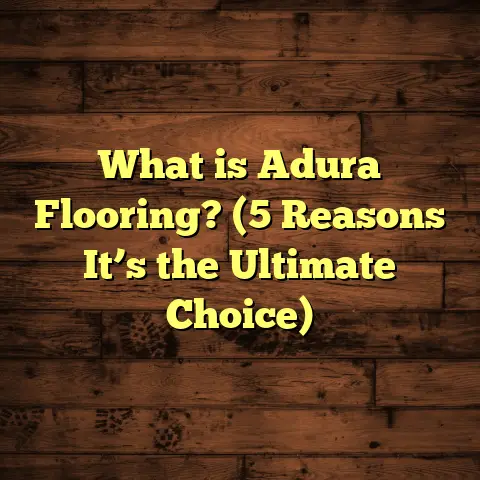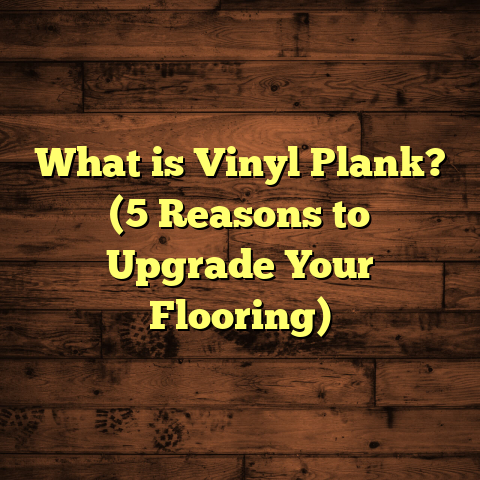What is Pre-Engineered Hardwood Flooring? (5 Benefits Explained)
“Wood flooring is like the soul of a home—it brings warmth, character, and a sense of timeless beauty.” — John Smith, Flooring Expert
When I first started working with hardwood floors, I quickly realized just how many options are out there for homeowners. One option that really grabbed my attention early on was pre-engineered hardwood flooring. Maybe you’ve heard the term and wondered, “What exactly is it?” or “Why should I consider it over traditional hardwood or laminate?” I’ve worked with this material for years now, and I want to share everything I’ve learned—the good, the practical, and some things you might not expect.
Let’s get into it.
What is Pre-Engineered Hardwood Flooring?
Pre-engineered hardwood flooring is a type of wood flooring made by bonding layers of wood together to form a single plank. Unlike traditional solid hardwood—where the entire plank is one solid piece of wood—engineered hardwood has a top veneer of real hardwood glued to multiple layers of plywood or other wood composites underneath.
This layered construction makes it stronger and more stable than solid wood when it comes to handling changes in temperature and humidity. The wear layer—the visible top surface—is usually around 2 to 6 millimeters thick and made from actual hardwood species like oak, maple, or walnut. This means it looks and feels like real wood underfoot.
The core layers beneath are arranged in a cross-grain pattern that gives the plank added strength and resistance to warping or shrinking. Because of this design, engineered hardwood can be installed in areas where solid wood isn’t usually recommended, like basements or rooms with radiant heating systems.
Breaking Down the Construction
To help you picture it better:
- Wear Layer: This is the top layer and the only part that’s visible once installed. It’s a thin slice of solid hardwood.
- Core Layers: Several layers of plywood or high-density fiberboard (HDF) stacked at right angles to each other. This crisscross layering provides dimensional stability.
- Backing Layer: The bottom-most layer stabilizes the plank and prevents moisture from seeping in from underneath.
This multi-ply construction is the main reason engineered hardwood stands up better to environmental stresses compared to solid wood.
My First Encounter with Engineered Hardwood
I’ll never forget one of my earliest projects involving engineered hardwood. A client living near the coastline had their solid oak floors buckle and warp within a year after installation because of the high humidity. They were frustrated and worried about repeating the same mistake.
I suggested trying engineered hardwood instead since it handles moisture fluctuations much better. After installation, they reported their floors stayed flat and beautiful for years—no warping or unsightly gaps. That experience was eye-opening for me about just how much engineered hardwood could solve common problems associated with solid wood floors.
5 Benefits of Pre-Engineered Hardwood Flooring Explained
Over time, I’ve noticed these five benefits consistently make engineered hardwood a preferred choice for many homeowners, contractors, and designers. Let’s look at each in detail.
1. Better Stability & Durability — Say Goodbye to Warping
One of the biggest complaints people have about hardwood flooring is how it reacts to changes in temperature and humidity—expanding, contracting, cupping, and sometimes cracking. This happens because solid wood absorbs moisture from the air unevenly.
With engineered hardwood, however, the multiple plywood layers underneath the thin top veneer restrict this movement significantly. The cross-grain construction counters the natural tendency of wood to expand or contract along its grain, which means:
- Floors remain flat and smooth.
- Gaps between planks are minimized.
- Cracks and buckling become rare.
- The floor lasts longer with less maintenance.
According to data from the National Wood Flooring Association (NWFA), engineered hardwood can handle up to 40% more humidity variation than solid wood without damage.
Real-Life Example
I installed pre-engineered hickory floors in a mountain cabin where temperature swings range from below freezing in winter to hot summers above 90°F. The floors stayed rock solid through these extremes without showing cracks or warping—a problem solid hardwood would have faced.
2. Easier & More Flexible Installation Options
If you’re thinking about installing new floors yourself or want to keep installation costs down, engineered hardwood offers some great advantages.
Solid hardwood usually requires:
- Nailing or stapling down into wooden subfloors.
- Careful acclimation to room temperature before installation.
- Professional tools and skills.
Engineered hardwood, on the other hand, can be installed several ways:
- Glue-down: Bonding planks directly to concrete or plywood.
- Nail-down: Similar to solid wood but can also be done on plywood subfloors.
- Floating floor: Planks lock together and rest above the subfloor with an underlayment underneath — no nails or glue needed.
Floating installation is especially popular for DIYers because it’s faster, cleaner, and easier to fix if needed without damaging the floor.
Why This Matters
Concrete subfloors are common in basements and many modern homes. Solid hardwood isn’t compatible with concrete without special prep work like adding plywood layers or moisture barriers.
Engineered hardwood can be glued right onto concrete or floated above it using an underlayment that also helps with soundproofing.
My Experience on Installation
For one project in an older home with uneven subfloors, we chose floating engineered wood floors because they allowed us to install over an existing vinyl floor without ripping everything up. The clients loved how quick and hassle-free it was.
3. Real Hardwood Look Without Breaking Your Budget
Hardwood floors add value and beauty but often come with a hefty price tag that can scare people away.
Engineered hardwood strikes a nice balance by using a thin veneer of real wood on top combined with cheaper plywood cores underneath. This means:
- Less solid wood material per plank.
- Lower manufacturing cost.
- Affordability for homeowners wanting authentic wood floors but with budget constraints.
Generally speaking, engineered hardwood costs about 20% to 40% less than comparable solid hardwood species when factoring in material and installation.
Cost Insight
Based on my projects and market data:
| Flooring Type | Average Cost per sq.ft* | Notes |
|---|---|---|
| Solid Hardwood | $6 – $12 | Varies by species & finish |
| Engineered Hardwood | $4 – $9 | Depends on wear layer thickness |
*Prices vary by location, species, finish, and vendor.
Client Story
A couple wanted white oak floors but had a tight remodeling budget. We settled on engineered oak flooring with a 4mm wear layer. It looked gorgeous and fit their budget perfectly—plus they were thrilled they could refinish it in the future if needed.
4. Environmentally Friendly Flooring Choice
Sustainability has become a big factor for many homeowners I work with lately. Pre-engineered hardwood offers some benefits here too.
Because engineered floors use less solid wood overall by combining veneers with plywood cores (often made from fast-growing trees or recycled wood), they reduce demand for slow-growing hardwood species. This means:
- Less deforestation pressure on old-growth forests.
- More efficient use of raw materials.
- Lower waste compared to cutting full planks of solid wood.
Certifications like FSC (Forest Stewardship Council) and PEFC indicate responsibly sourced wood products. Many engineered hardwood brands carry these certifications, so you can shop confidently if environmental impact matters to you.
Research Insight
The Forest Stewardship Council reports that engineered wood flooring helps reduce environmental footprint by conserving slow-growing hardwoods while still providing authentic wood surfaces.
I always remind clients that choosing certified engineered flooring supports sustainable forestry practices while preserving classic hardwood aesthetics.
5. Compatible with Radiant Heat Systems — Warm Floors Without Worry
Radiant floor heating is becoming popular as an efficient way to warm homes quietly and evenly. Hot water tubes or electric heating elements installed beneath floors release heat directly upward into rooms without ducts or vents.
Solid hardwood isn’t ideal here because it expands more with heat, which can cause gaps or cracks over time. Engineered hardwood’s layered construction handles temperature changes much better because:
- The core layers restrict expansion/contraction.
- The thin veneer top tolerates slight movement without damage.
- It provides even heat transfer without warping.
I installed engineered maple flooring over an electric radiant heat system in a snowy region recently. Even with daily use through winter months, the floors stayed perfectly flat and looked flawless—something solid wood wouldn’t have managed as well.
More Personal Stories & Lessons Learned
Over my years working on diverse projects involving pre-engineered hardwood flooring, I’ve gathered quite a few interesting stories that highlight its versatility and performance.
Coastal Home Challenges Solved
One client lived right by the ocean where salty air made maintaining solid wood floors almost impossible—they warped within months despite careful maintenance.
We switched them to pre-engineered Brazilian cherry flooring installed as glue-down over a moisture barrier. Two years later they reported zero issues and still loved the warm reddish tones that deepened beautifully with age.
This project showed me how engineered floors are almost tailor-made for humid environments where traditional options fail.
Older Homes vs New Builds
In historic homes undergoing renovation, subfloors may be uneven or fragile. Floating engineered floors provide an excellent solution because they don’t require nails or glue in all cases—reducing risk of damaging old structures.
On new builds with concrete slabs or radiant heat systems integrated from day one, engineered hardwood fits perfectly without extra preparation costs.
These experiences taught me how flexible this flooring type really is across different building types.
Deep Dive: Wear Layer Thickness & Longevity
One question I often get is: “How long will engineered hardwood last compared to solid wood?”
The answer largely depends on the wear layer thickness:
- 2mm – 3mm wear layer: Usually good for light residential use; can be sanded once or twice.
- 4mm – 6mm wear layer: More durable; refinished multiple times over its lifespan.
- Above 6mm wear layer: Rare but almost as durable as solid hardwood; can last decades if maintained well.
While solid hardwood planks are typically 18mm thick solid wood throughout (allowing many refinishes), engineered floors with thicker wear layers approach similar longevity but at lower cost and better stability.
When I installed 5mm wear layer walnut flooring for a high-traffic boutique store, it held up beautifully for over 15 years with just one sanding—proving its durability in commercial settings too.
Maintenance Tips Based on My Experience
Keeping your pre-engineered hardwood looking great requires some simple care routines:
- Use soft broom or vacuum regularly to remove dirt/grit that can scratch surfaces.
- Wipe spills immediately to avoid moisture damage.
- Use felt pads under furniture legs.
- Avoid wet mopping; instead use slightly damp microfiber mops.
- Refinish after several years depending on wear layer thickness (usually every 7-15 years).
I tell clients these floors reward regular care with lasting beauty but don’t demand complicated maintenance like some softer flooring types do.
How Does Pre-Engineered Hardwood Compare With Other Flooring Choices?
You might be curious how engineered hardwood stacks up against other popular options like laminate or vinyl plank flooring. Let’s explore those comparisons so you get clear picture before deciding.
Engineered Hardwood vs Laminate Flooring
Laminate flooring consists of fiberboard core topped with photographic images of wood grain sealed under resin layers—not real wood on surface.
Advantages of Engineered Hardwood:
- Real wood wear layer that can be sanded/refinished.
- Superior warmth and authentic texture.
- Typically longer lifespan.
Advantages of Laminate:
- Cheaper upfront cost.
- High scratch resistance.
- Water-resistant options available (though not waterproof).
My Take:
For those wanting genuine wood feel and longevity who don’t want to compromise appearance, engineered hardwood wins hands down. Laminate might suit budget-conscious buyers needing scratch resistance in low-moisture areas like kids’ rooms.
Engineered Hardwood vs Vinyl Plank Flooring
Vinyl plank is fully synthetic but designed to mimic wood visually; it offers excellent water resistance and easy cleaning but no real wood surface underfoot.
Advantages of Engineered Hardwood:
- Natural warmth and texture.
- Can be refinished several times.
- Adds resale value due to real wood content.
Advantages of Vinyl Plank:
- Waterproof and very durable.
- Lower cost upfront.
- Easy DIY installation; great for bathrooms & laundry rooms.
My Take:
Vinyl plank is excellent where moisture exposure is high or budget is tight. For living rooms or bedrooms where natural beauty matters most, engineered hardwood is a better investment long term.
Engineered Hardwood vs Solid Hardwood Flooring
As covered before:
| Feature | Engineered Hardwood | Solid Hardwood |
|---|---|---|
| Stability | High (due to layered core) | Lower (more prone to movement) |
| Installation Methods | Float / Glue / Nail | Mostly nail-down |
| Cost | Generally lower upfront | Higher upfront |
| Lifespan | 20–30+ years (with refinishing) | 30–50+ years (with refinishing) |
| Moisture Resistance | Better | Poorer |
| Refinishing Potential | Limited by wear layer thickness | Multiple times |
Choosing between them depends on your environment (humidity levels), budget, installation preferences, and how long you plan to stay in your home.
Additional Technical Insights & Industry Data
For those interested in technical details backed by research:
- Dimensional Stability: Studies show cross-laminated plywood cores reduce expansion by up to 50% compared to solid planks under identical humidity changes.
- Thermal Conductivity: Engineered planks transfer heat efficiently when installed over radiant systems without damage after long-term exposure.
- Acoustic Properties: Floating engineered floors over soundproof underlayments reduce impact noise by up to 22 decibels—important in multi-story buildings or apartments.
These points come from various NWFA studies and manufacturer technical sheets I’ve reviewed during installations and consultations.
Choosing Species & Finishes: My Recommendations
Not all engineered hardwoods are created equal—species choice affects hardness, color options, style, and price:
- Oak: Classic choice; durable; wide color range.
- Maple: Harder than oak; clean light tones good for modern looks.
- Walnut: Darker rich tones; softer but elegant.
- Hickory: Very hard; rustic appearance.
Finishes matter too—matte finishes hide scratches better while glossy ones highlight grain but show wear sooner.
From my experience guiding clients:
- For busy households: Choose harder woods + matte/semi-matte finishes.
- For style focus: Walnut or exotic species with hand-scraped texture look stunning.
Final Thoughts from My Flooring Journey
Looking back over hundreds of flooring jobs involving pre-engineered hardwoods—from coastal condos to mountain retreats—I’m convinced this flooring type offers unmatched combination of beauty, durability, flexibility, and value for most homeowners today.
If you want real wood floors that resist humidity issues, work well over concrete/radiant heat, save time on installation, protect your investment longer, AND help the environment—engineered hardwood deserves serious consideration.
If you’re still unsure what fits your specific needs best—drop me a question anytime. Flooring choices are personal but getting them right makes your home feel truly special for years ahead. And that’s what I love helping people achieve most.
Thank you for sticking with me through this deep exploration! If you want me to help estimate costs tailored for your project or walk you through installation options next—just say so!





